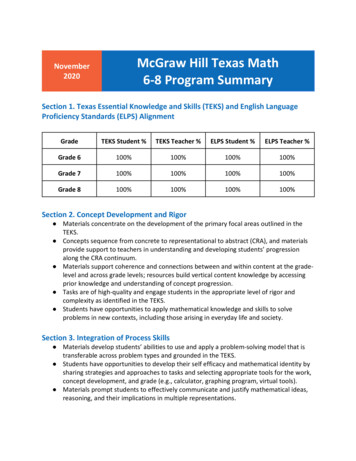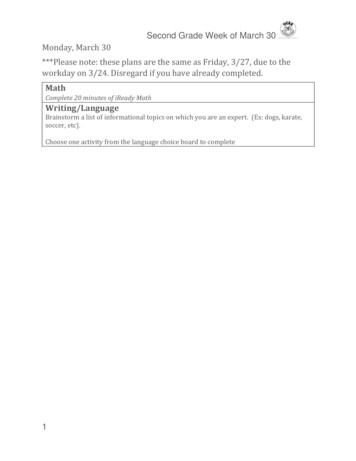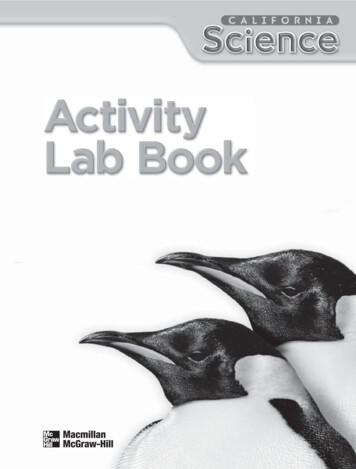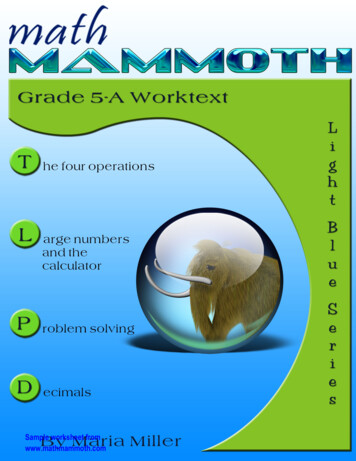
Transcription
McGraw Hill Texas Math6-8 Program SummaryNovember2020Section 1. Texas Essential Knowledge and Skills (TEKS) and English LanguageProficiency Standards (ELPS) AlignmentGradeTEKS Student %TEKS Teacher %ELPS Student %ELPS Teacher %Grade 6100%100%100%100%Grade 7100%100%100%100%Grade 8100%100%100%100%Section 2. Concept Development and Rigor Materials concentrate on the development of the primary focal areas outlined in theTEKS. Concepts sequence from concrete to representational to abstract (CRA), and materialsprovide support to teachers in understanding and developing students’ progressionalong the CRA continuum. Materials support coherence and connections between and within content at the gradelevel and across grade levels; resources build vertical content knowledge by accessingprior knowledge and understanding of concept progression. Tasks are of high-quality and engage students in the appropriate level of rigor andcomplexity as identified in the TEKS. Students have opportunities to apply mathematical knowledge and skills to solveproblems in new contexts, including those arising in everyday life and society.Section 3. Integration of Process Skills Materials develop students’ abilities to use and apply a problem-solving model that istransferable across problem types and grounded in the TEKS. Students have opportunities to develop their self efficacy and mathematical identity bysharing strategies and approaches to tasks and selecting appropriate tools for the work,concept development, and grade (e.g., calculator, graphing program, virtual tools). Materials prompt students to effectively communicate and justify mathematical ideas,reasoning, and their implications in multiple representations.
Section 4. Progress Monitoring Materials include developmentally appropriate diagnostic tools and guidance forteachers and students to monitor progress. Guidance is provided for teachers and administrators to analyze and respond to data forplanning further instruction. Materials include frequent, integrated formative assessment opportunities and routineprogress monitoring opportunities.Section 5. Supports for All Learners Materials include guidance, scaffolds, supports, and extensions that maximize studentlearning potential; targeted instruction and activities are provided for students whostruggle with content mastery. Instructional methods appeal to a variety of learning interests and needs. Materials include supports for English Learners (ELs) with sequenced and scaffoldedlinguistic accommodations commensurate with various levels of English languageproficiency.Section 6. Implementation Materials include a cohesive, year-long plan with practice and review opportunities thatsupport instruction. Materials are designed in a way that allows Local Education Agencies the ability toincorporate the curriculum into district, campus, and teacher design and considerations.Guidance for implementation is provided that ensures the sequence of content is taughtin an order that is consistent with developmental progression of mathematical conceptsand skills. The visual design of student and teacher materials is neither distracting nor chaotic.Section 7. Additional Information The publisher submitted the technology, cost, and professional learning supportworksheets.
November2020McGraw Hill Texas MathGrade 72.1 Materials concentrate on the development of the primary focal area(s) for the gradelevel. Materials spend the majority of concept development of the primary focal areas forthe grade-level as outlined in the TEKS. Materials strategically and systematically develop students’ content knowledge asappropriate for the concept and grade-level as outlined in the TEKS. Materials provide practice opportunities for students to master the content.Meets 4/4Throughout the lessons, the materials concentrate on the development of the primary focalareas for the grade-level as outlined in the TEKS. In addition, materials strategically andsystematically develop this content knowledge through appropriate practice opportunities,ensuring students achieve proficiency.Evidence includes but is not limited to:The online materials contain resources that clearly state the focal areas of a unit, and thosefocal areas align with the grade-level TEKS. The chapters can be broken down by focal area,with Chapter 1 covering Rational Number Operations, Chapters 2–6 covering ProportionalRelationships, Chapters 7–8 covering Expressions and Equations, and Chapter 9 covering moreon Proportional Relationships and Data. Academic rigor increases over time to meet the fullintent of the primary focal areas. Each chapter’s “Teacher Plan” includes a “Practice and Apply”section that summarizes how problems increase in complexity level from 1–4. These levelsroughly correspond to the levels on Bloom’s Taxonomy.Each chapter begins with an “Are You Ready?” check to ensure the student has the necessaryskill set to be successful. If students are unsuccessful, teachers have access to a quick reviewand four reteach options. Each chapter includes a TEKS trace, chapter overview, and pacingguide. TEKS trace focuses on the progression of knowledge and skills within the grade level.Chapter overviews highlight what students have already learned and what they will nowdevelop. Pacing guides clearly state the focal areas of individual lessons. For example, a chapteron statistics and sampling includes background and TEKS information for bar graphs, dot plots,circle graphs, making predictions, misleading and appropriate statistics, and comparing twopopulations. Additionally, each lesson plan lists how exercises, problems, and questions align
with the TEKS. One example of this is in the lesson on the probability of compound events,which requires multiple steps and integrates TEKS from multiple grades and focal areas.Lessons display the importance of introducing and reviewing key concepts by outlining howprevious concepts relate to current concepts. In Chapter 5, the previous concept had studentsmake predictions and determine solutions using experimental data for simple and compoundevents; the lesson plan describes how this concept aligns with the current concept of havingstudents determine theoretical probabilities related to compound events using sample spaces.The “Teach the Concept” portion of each lesson summarizes how to introduce each conceptwhile also providing the teacher guidance for students who are approaching, on, or beyondgrade level. This section sometimes includes alternative strategies for students to collaborateand additional suggested TEKS for spiraling.Each lesson includes real-world situations promoting the application of mathematics toeveryday life. For example, in Chapter 5, a real-world link describes independent as a commonword in the English language. Students use a dictionary to look up the definition of independentand explain how the dictionary can help you remember the mathematical definition of theword. Within each lesson, students have ample opportunity to practice focal area skills.In Chapter 9, students generate data and create both bar and circle graphs. Within thedifferentiation guide, teachers have access to differentiation recommendations for verbal,auditory, and kinesthetic learners. This leads into the rest of the lesson, where they formallylearn the process for creating circle graphs. Generally speaking, students practice through setsof examples, guided practice, multi-step problem solving, and “HOT Problems,” or Higher-OrderThinking problems. Beyond this, teachers have access to alternative activities and chapterprojects so students can practice necessary skills. Finally, diagnostic, formative, and summativeassessments are interwoven between lessons; teachers can use these results to plan andprovide students individualized intervention.
November2020McGraw Hill Texas MathGrade 72.2 Materials sequence concepts from concrete to representational to abstract (CRA) as isappropriate for the grade-level and content. Materials include a variety of types of concrete models and manipulatives, pictorialrepresentations, and abstract representations, as appropriate for the content andgrade level. Materials support teachers in understanding and appropriately developing students’progression along the CRA continuum.Meets 4/4The materials sequence concepts from concrete to representational to abstract (CRA) as isappropriate for the grade level and content. Throughout the lessons, the materials include avariety of types of concrete models and manipulatives, pictorial representations, and abstractrepresentations, as appropriate for the content and grade level. They also support teachers inunderstanding and appropriately developing students’ progression along the CRA continuum.Evidence includes but is not limited to:The online virtual manipulatives resource included with each lesson provides students with adigital means to explore concepts and teachers with a way to create problem-based learningopportunities. The resource contains algebra tiles, base ten blocks, centimeter cubes, a clock,connecting cubes, currency, fraction circles and tiles, geoboard and bands, a hundreds chart,number cubes, number lines, a spinner, tangrams, a thermometer, and two-color counters. Alsoincluded in this resource is a variety of hands-on manipulatives to be used within theclassroom. The materials provide pictorial models within the lesson components so thatstudents can transition from their concrete exploration to representational practice. To furtherincrease the rigor towards the abstract, the materials include multi-step problem solving andhigher-order thinking questions.Throughout the materials, teachers are given suggestions on how to understand andappropriately develop students’ progression through the CRA continuum, whether they areapproaching, on, or beyond grade-level proficiency. The “Are You Ready?” section in thechapter overview of the teacher plan has quick checks for the teacher to gauge studentunderstanding, and if students have difficulty with any exercises, the materials provide anadditional example to clarify misconceptions. This section also included a diagnostic test.
Chapter 1, Rational Numbers, begins with a graphic explaining when students will be able toapply the information learned into their real life. It continues with a foldable then moves on totables, numbers lines, and Venn Diagrams to reinforce the concept.In Chapter 2, teachers are provided with guidance teaching unit rate by pointing out to studentsthat the positions of the quantities being compared in a rate can be reversed. In one pictorialrepresentation, the unit rate given is four juice boxes per dollar. Students are encouraged toanalyze the problem to determine which rate is more helpful. If a person wanted to know howmany juice boxes they could buy for 7, the unit rate per dollar would be more helpful. But if aperson wanted to compare the cost of juice boxes at different stores, the unit price per juicebox would be more helpful.In Chapter 4, students work on modeling circumference. Students cut string the length of thecircumference of circular objects and measure the diameter. After measuring thecircumference of several objects, students complete a table. This table includes the object,circumference, diameter, and the ratio of circumference to diameter. Students then createtheir own rule based on what they notice about the circumference and diameter ratio. Studentsthen progress within the activity by predicting circumference based on the diameter and testtheir rules. This chapter also includes a hands-on lab lesson that uses models for the area ofcircles. The students are instructed to fold a paper plate in half four times to divide it into sixequal sections. The students then label the parts of a circle, including the radius andcircumference. Later the students are asked to cut out each section of the circle.In a hands-on lab lesson in Chapter 5 on modeling proportional relationships, students usecentimeter cubes to arrange the number of replies two students received in an onlinediscussion group. Each student posted four comments, and a table shows the number of repliesfor the first two comments. From the information given, students complete a table and graphdata on a coordinate plane to determine if each data set represents a proportional relationship.Later in Chapter 5, students see how a proportion is an equation. In the introduction, studentscomplete an example of solving proportions using cross products. Following the introduction,the guided and independent practice contains a variety of questions asking students to solveproportions with and without models. The materials include common error guidance aslearners transition to abstract concepts.In a hands-on lab lesson in Chapter 7, students use algebra tiles to model and solve two-stepequations. The lesson then launches into pictorial representations in the form of algebra tilesfor students to reference while practicing. The chapter has bar diagrams for students to view tobetter connect the concept of solving equations. Students also solve multi-step problems andhigher-order thinking questions labeled as create, analyze, and evaluate. The models,manipulatives, and representations are used for concept exploration and attainment for theprimary focal area requiring students to recreate the manipulatives used during the lesson bydrawing the concept to show understanding.
November2020McGraw Hill Texas MathGrade 72.3 Materials support coherence and connections between and within content at the gradelevel and across grade levels. Materials include supports for students to build their vertical content knowledge byaccessing prior knowledge and understanding of concept progression. Materials include tasks and problems that intentionally connect two or more conceptsas appropriate for the grade-level. Materials provide opportunities for students to explore relationships and patternswithin and across concepts. Materials support teachers in understanding the horizontal and vertical alignmentguiding the development of concepts.Meets 4/4The materials provide strategic and integrated instruction in all components of mathematicalrigor: conceptual understanding, procedural fluency, and application. Throughout the lessons,the materials include some support for students to build their vertical content knowledge byaccessing prior knowledge and understanding of concept progression. The materials alsoinclude some tasks and problems that intentionally connect two or more concepts, asappropriate, for the grade level and provide opportunities for students to explore relationshipsand patterns within and across concepts. The materials have support for teachers inunderstanding the horizontal and vertical alignment guiding the development of concepts.Evidence includes but is not limited to:The materials include supports for students to build their vertical content knowledge byaccessing prior knowledge and understanding of concept progression. The materials containtasks that use familiar models and strategies from previous units but do not always connect towhat will be used in future grade levels. The “Plan and Present” resource in each chaptercontains tasks that help students connect concepts that are appropriate to their grade level.Even though the materials provide opportunities to understand how mathematical ideas mightconnect to one another, there is limited evidence the materials help teachers question studentsin order to make connections between concepts. The suggested questions for teachers aredirectly related to the concept being taught. For example, the launch of the lesson may providestudents the opportunity to examine patterns within a concept to make connections, but thereis less evidence of examining relationships across concepts.
In the digital components, within the “Teach the Concept” tab, a section entitled“Mathematical Background” explains how to connect new learning to previously learnedconcepts, knowledge, and skills. For example, in Chapter 4, Understand Proportions, beforeaddressing equivalent rates and ratios, the material provides teachers with options to reviewpreviously learned methods (bar diagrams, proportions, equivalent fractions, unit rates, doublenumber lines) to solve prediction and comparison problems involving ratios and rates.The materials do provide opportunities for students to connect to previously learned concepts,knowledge, and skills. In Chapter 7, Equations and Inequalities, one lesson begins with the “AreYou Ready?” section that consists of a “Quick Review” and a “Quick Check.” In the Quick Reviewsection, students demonstrate previously learned concepts with two examples. In example one,students write the phrase as an algebraic expression. In example two, students use numbers tofind the solution to the equation. In the Quick Check sections, students solve problems that aredirectly related to the examples explained prior. The materials provide vertical contentknowledge by providing the teacher with a “Lesson Launch” for each lesson in the unit. Theselaunches use prior student understanding to prepare students for what is to come. Teachers arealso given a diagnostic test to administer to students in order to gauge their understanding ofthe previously learned concepts, knowledge, and skills.The materials also include tasks and problems that intentionally connect two or more conceptsas appropriate for the grade level. The materials also provide some opportunities for studentsto explore relationships and patterns within and across concepts. The multi-step problemsolving contains spiral review, and the teacher examples mention a specific strategy. In aChapter 7 lesson on solving equations with rational coefficients, there is a “TEKS Skill Trace”provided. TEKS Skill Traces map concepts students have already learned, what they will learn inthis lesson, and what they will learn in future lessons and are available for each lesson. Prior tothis lesson, students take part in a hands-on lab to model and solve equations. This lab usessimilar bar diagrams as the students used in a prior lesson on percentages. The students use abar diagram to organize the situation.The “Plan and Present” resource in each chapter of the materials includes support for theteachers in understanding the horizontal and vertical alignment guiding the development ofconcepts. Within the Chapter Overview, the section entitled “Mathematical Background”explains how the skills covered in each lesson progress vertically and horizontally, enhancingthe teacher’s understanding of how students should progress in their knowledge and skillsthroughout the materials. However, information about how the materials align to the nextgrade is not always provided. In Chapter 7, Equations and Inequalities, the mathematicalbackground for Lessons 2 and 3, One-Step Equations, explains that in previous grades, studentsmodeled and solved one-step equations, and they will increase their fluency in solving theseequations using rational numbers. The materials direct teachers to have students recall theproperties of equality in order to solve equations. For Lessons 4 and 5, Two-Step Equations, themathematical background provides a horizontal reference to earlier in the chapter whenstudents learned how to write and solve one-step equations. They are provided with a table of
contents and brief pacing, which provides the topic and a suggested number of days. Teachersare also given a correlation document that outlines which TEKS are covered in each lesson.There is some correlation provided to teachers between current TEKS and those covered inprevious grade levels, hinting at vertical alignment; however, there is no evidence in thematerials that teachers are provided with an explanation of the depth, breadth, and complexityof current concepts and their connections to the expectations of student understanding for thenext year.
November2020McGraw Hill Texas MathGrade 72.4 Materials are built around quality tasks that address content at the appropriate level ofrigor and complexity. Tasks are designed to engage students in the appropriate level of rigor (conceptualunderstanding, procedural fluency, or application) as identified in the TEKS and asappropriate for the development of the content and skill. Materials clearly outline for the teacher the mathematical concepts and goals behindeach task. Materials integrate contextualized problems throughout, providing students theopportunity to apply math knowledge and skills to new and varied situations. Materials provide teacher guidance on anticipating student responses and strategies. Materials provide teacher guidance on preparing for and facilitating strong studentdiscourse grounded in the quality tasks and concepts.Meets 4/4The materials are built around quality tasks, designed to engage students, that address contentat the appropriate level of rigor and complexity (conceptual understanding, procedural fluency,or application) as identified in the TEKS and as appropriate for the development of the contentand skill. Throughout the lessons, the materials integrate contextualized problems, providingstudents with some opportunity to apply math knowledge and skills to new and variedsituations. The materials also include some teacher guidance on anticipating student responsesand strategies. The “Mathematical Processes Handbook” outlines for the teacher themathematical concepts and goals behind each task.Evidence includes but is not limited to:Throughout the materials, students are guided through CRA with increasing depth andcomplexity. In Chapter 1, conceptual understanding is built by launching the lesson by havingstudents determine which fractional part of students eating a hamburger also chose to ordercheese. The teacher-led examples in this lesson progress through the procedure by multiplyingrational numbers by simplifying first. The guided practice continues to move throughprocedural to real-world problems and concludes with multi-step problem solving. Each lessonthroughout the materials follows this pattern to ensure students work through the CRAprocess. As the year progresses, the complexity of the units increases. The seventh-grade unitsstart with rational numbers and proportional relationships. The skills learned in these chapters
are used in future units, such as proportionality to percent, probability, geometry, equations,and linear relationships. The skills learned continue to build from one unit to the next. Theseventh-grade units end with statistical analysis and personal financial literacy.Students work through the CRA process, and the materials outline for the teacher themathematical concepts and goals behind each task. The materials provide a mid-chapter checkand formative assessments in the guided practice section to assess students' understanding ofthe concepts being taught in each lesson. Chapter 1 has a formative assessment where theteacher has students work in pairs to complete Exercises 1–3. One student verbally walksthrough the steps to determine each product while the other student listens and encourages.After each exercise, the teacher has the second student ask clarifying questions. There is someevidence that explaining how following the progression of each task builds student efficacytowards mastery or conceptual understanding.The materials integrate contextualized problems throughout, providing students someopportunity to apply math knowledge and skills to new and varied situations. In Chapter 1,students have to compare and order fractions from different real-world scenarios. One suchcontext is to determine what fraction of students who watch a particular show actuallyrecorded the show. Although the context of the problems presents students with fractions indifferent world scenarios, the problems do not include operations with decimals, which wouldbe included in the grade-level appropriate TEKS.The materials provide some teacher guidance on anticipating student responses and strategies.For example, the “Plan and Present” section in the teacher reference section reviews essentialquestions and provides sample answers. The “Practice and Apply” tab includes a sectionentitled “Watch Out,” which provides teachers with common misconceptions on studentresponses and strategies, as well as how to combat those misconceptions. In Chapter 1, Lesson6, Fluently Add and Subtract Rational Numbers: Unlike Fractions, the materials direct teachersto watch for students who may have trouble with adding and subtracting unlike fractions if theyonly rename the denominators using the LCD. Teachers should have students show by whatnumber they are multiplying both the numerator and denominator to rename the fraction. Theexamples in the teacher plan may have teachers use a specific strategy, but they do notrationalize as to why the strategy is appropriate at that time. The materials are not sequencedbased on the complexity of the strategy, but rather on the ability level of the students or thecomplexity of the questions, which can be identified in the practice and apply section of theteacher plan.The materials provide some teacher guidance on preparing for and facilitating strong studentdiscourse grounded in the quality tasks and concepts. Throughout the materials, teachers areprovided with questions and activities to facilitate and support discourse, but there are norubrics to provide feedback during verbal discourse. In Chapter 6, teachers are provided withdirections in facilitating students through the activities of “Round Robin” and “Find the Fib.” Toengage in Round Robin, teachers have students work in pairs to complete an exercise. Student1 generates an x-coordinate. Then Student 2 generates the corresponding y-coordinate. Then
Student 1 graphs the ordered pair on the coordinate plane. Students alternate roles for eachnew x-coordinate. Teachers are not provided with how to direct student misunderstandings ormisconceptions. In the materials, rubrics are provided for the performance-based tasks, butthere is no evidence of rubrics provided for teachers to give students feedback based ondiscourse. The ELL guide does provide rubrics to assess the oral and writing skills of studentswho are English Learners, but not all students.
November2020McGraw Hill Texas MathGrade 72.5 Materials include cohesive, year-long plan for students to develop fluency in anintegrated way. Materials include teacher guidance and support for conducting fluency practice asappropriate for the concept development and grade. Materials include a year-long plan for building fluency as appropriate for the conceptdevelopment and grade. Materials integrate fluency at appropriate times and with purpose as studentsprogress in conceptual understanding. Materials include scaffolds and supports for teachers to differentiate fluencydevelopment for all learners.Meets 4/4The materials provide teacher guidance and support for conducting fluency practice asappropriate for the concept development and grade. Materials integrate fluency at appropriatetimes and with purpose as students’ progress in conceptual understanding. Additionally,materials contain some scaffolds and supports for teachers to differentiate fluencydevelopment for all learners.Evidence includes but is not limited to:Materials include some teacher guidance and support for conducting fluency as appropriate forthe concept development and grade. Each lesson progresses from basic practice to “HigherOrder Thinking” (HOT) questions. The mathematical backgrounds included in each chapteroverview explains how students achieved conceptual understanding in prior grades. Then, inthe lessons that follow, the materials contain reteach strategies as well as strategies andtechniques on how students who have not yet shown fluency can hone or demonstrate theirfluency with the “new” material. The materials provide fluency activities that encouragestrategic and flexible use of strategies.The “English Language Learner’s Guide: Book G” provides the teacher with a comprehensivereference that supports connections between concept development and fluency. The guidebegins with “Building Math Concepts” and “Language Skills.” It includes sections like “HelpingAll Children Learn Mathematics” and “Integrating Language Development with Mathematics.”The Integrating Language Development with Mathematics section is broken down into seven
key goals that allow teachers to meet the challenges of combining second language instructionwith mathematics. However, there is no evidence that the materials provide a description ofthe purpose behind the fluency practice within these programs.The materials integrate fluency opportunities as appropriate for the concept development andgrade, but it is not always explicitly stated. Lesson 5-a models how to add and subtract rationalnumbers and targets students’ understanding of how to use number lines to model additionand subtraction. Students use number lines to complete several more problems, but there is noreference to building fluency. In Lesson 1-9, the teacher asks an approaching level student howany whole number can be expressed as a fraction, and then the reciprocal of that fraction.Reteach activities are provided for the current lesson only and not a previous skill to helpstudents who have not yet mastered the desired level of fluency make connections to previousconcepts. Instead, fluency practice worksheets are found online.The materials do include scaffolds and supports for teachers to differentiate fluencydevelopment for all learners. The “Plan and Present” resource included with each lessonthroughout the materials provides scaffolding suggestions for students needing additionalexperiences and opportunities to meet grade-level fluency expectations. For example, with
McGraw Hill Texas Math Grade 7 ; 2.1 ; Materials concentrate on the development of the primary focal area(s) for the grade-level. Materials spend the majority of concept development of the primary focal areas for










